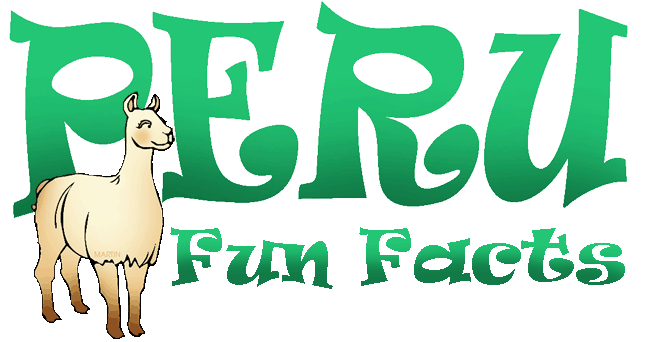Fun Facts about
Peru
Peru got it's name from Francisco
Pizarro, the Spanish conqueror. He named the land after a local
leader in Panama in the 1600's named Biru.
Caral, a little over a hundred miles north of Lima, is the oldest known city in the Americas, dating back to 3000 BC.
The Nazca lines of Peru remain a mystery. No one knows why they were made thousands of years ago. Among the hundreds of creatures found in the desert include hummingbirds, spiders, llamas, and lizards as well as geometric shapes.
The Inca Empire was the largest empire in Pre-Columbian America. From 1438 to 1533, the empire expanded across the Andes Mountains to include parts of Colombia, Ecuador, Peru, Bolivia, Argentina, and Chile. In 1532, Spanish conquistador Francisco Pizarro arrived with 168 men, one cannon, and 27 horses with the goal of conquering the Inca empire. He was aided by civil war within the empire, unrest among newly conquerored areas, and smallpox.
Peru was the last Spanish colony in South America to gain independence, declaring independence in 1821.
Cusco, the capital of the Inca Empire, has over two million tourists a year. Most, if not all of them, are there to visit Machu Picchu, an astronomical observatory and hidden fortress in the mountains that the Spanish conquerors never located. Machu Picchu is called "the Lost City of the Incas".
Lake Titicaca, the world's highest navigable lake at the south of Peru, has man made floating islands created by the Uros Indians. They use totora reeds to make the islands, their homes, boats, and even eat the reeds. On the Bolivian side of the lake are the Islands of the Sun and Moon, sacred in Inca traditions. It is a big like. It's about the combined size of Rhode Island and Delaware.
Potatoes, Tomatoes, and Avocados are originally from Peru. My favorite food, the potato, comes in 3,000 varieties. The corn grown in Peru has the biggest kernels in the world.
Sunflowers also originated in Peru. Because they look like the sun, the Incas revered the flowers.
The Andes Mountains (the world's second longest mountain chain) cross Peru north to south with 50 peaks over 6000 meters (19,685 feet).
Of course, everyone knows that the Amazon River crosses Brazil and is the world's largest river by volume. But, did you know that the river begins in Peru?
Spanish is the main language spoken in Peru. However, Quechua (the language of the Incas) and Aymara are also spoken, mainly in the mountain regions. The Incas did not have a written language. They kept records on quipus, cords with a series of knots. Today, Quechua is a written language. If you want to say, "How are you?" it is " Alli lan chu k'asan qui." That's pronounce "ah lee LAHN choo kah SAN key".
Caral, a little over a hundred miles north of Lima, is the oldest known city in the Americas, dating back to 3000 BC.
The Nazca lines of Peru remain a mystery. No one knows why they were made thousands of years ago. Among the hundreds of creatures found in the desert include hummingbirds, spiders, llamas, and lizards as well as geometric shapes.
The Inca Empire was the largest empire in Pre-Columbian America. From 1438 to 1533, the empire expanded across the Andes Mountains to include parts of Colombia, Ecuador, Peru, Bolivia, Argentina, and Chile. In 1532, Spanish conquistador Francisco Pizarro arrived with 168 men, one cannon, and 27 horses with the goal of conquering the Inca empire. He was aided by civil war within the empire, unrest among newly conquerored areas, and smallpox.
Peru was the last Spanish colony in South America to gain independence, declaring independence in 1821.
Cusco, the capital of the Inca Empire, has over two million tourists a year. Most, if not all of them, are there to visit Machu Picchu, an astronomical observatory and hidden fortress in the mountains that the Spanish conquerors never located. Machu Picchu is called "the Lost City of the Incas".
Lake Titicaca, the world's highest navigable lake at the south of Peru, has man made floating islands created by the Uros Indians. They use totora reeds to make the islands, their homes, boats, and even eat the reeds. On the Bolivian side of the lake are the Islands of the Sun and Moon, sacred in Inca traditions. It is a big like. It's about the combined size of Rhode Island and Delaware.
Potatoes, Tomatoes, and Avocados are originally from Peru. My favorite food, the potato, comes in 3,000 varieties. The corn grown in Peru has the biggest kernels in the world.
Sunflowers also originated in Peru. Because they look like the sun, the Incas revered the flowers.
The Andes Mountains (the world's second longest mountain chain) cross Peru north to south with 50 peaks over 6000 meters (19,685 feet).
Of course, everyone knows that the Amazon River crosses Brazil and is the world's largest river by volume. But, did you know that the river begins in Peru?
Spanish is the main language spoken in Peru. However, Quechua (the language of the Incas) and Aymara are also spoken, mainly in the mountain regions. The Incas did not have a written language. They kept records on quipus, cords with a series of knots. Today, Quechua is a written language. If you want to say, "How are you?" it is " Alli lan chu k'asan qui." That's pronounce "ah lee LAHN choo kah SAN key".
